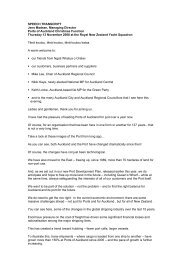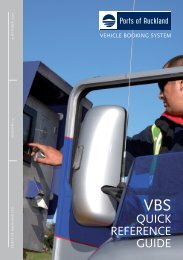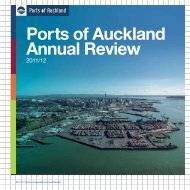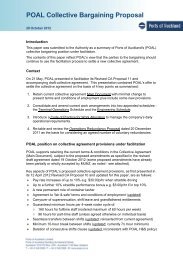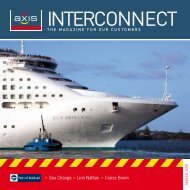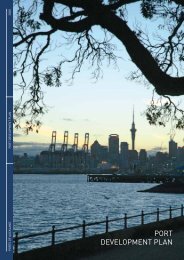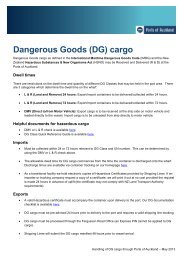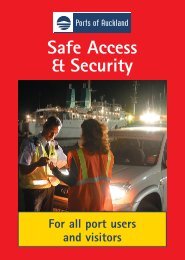2007-2008 - Ports of Auckland
2007-2008 - Ports of Auckland
2007-2008 - Ports of Auckland
Create successful ePaper yourself
Turn your PDF publications into a flip-book with our unique Google optimized e-Paper software.
0204060810121416PREPARING FOR THE FUTURE<strong>Ports</strong> <strong>of</strong> <strong>Auckland</strong> Annual Review <strong>2008</strong>Despite New Zealand’s isolation from the rest <strong>of</strong> the world, we arecloser than ever before to our trading partners. Advances in shippingand port operations mean New Zealand goods can go from port tooverseas market, and vice versa, in a matter <strong>of</strong> just days or weeks.And as shipping lines, services and ports consolidate and rationalise,the global shipping community is shrinking and powerful industryplayers are emerging.There is a global trend towards bigger ships. Since 2004, theaverage TEU volume per container ship call has increased 20% andit won’t be long before we see the next generation <strong>of</strong> larger containervessels in New Zealand waters. As ships get bigger, they call less<strong>of</strong>ten and to fewer ports – and from this comes hubbing.This environment creates opportunities, but also significant risks,not just for <strong>Ports</strong> <strong>of</strong> <strong>Auckland</strong> but for New Zealand as a country. Indeedour interests are interlinked: 48% <strong>of</strong> the North Island container trade and36% <strong>of</strong> New Zealand’s total container trade moves through <strong>Auckland</strong>.Both inside our gates and outside them, <strong>Ports</strong> <strong>of</strong> <strong>Auckland</strong> istaking the lead, making sure we are prepared to serve New Zealandwell into the future.In recent years, we have made significant investments toenhance our capacity and logistics capability. As this new worldarrives, we are working to complement our existing advantages <strong>of</strong>scale and proximity to market with innovative projects and initiativesdesigned to cement our place as a leading Australasian hub port.These initiatives include new machinery, such as energy-efficientstraddle carriers and cranes with higher lifting capacities, a suite <strong>of</strong>new technology projects and major infrastructure developments.Worldwide, there is also growing pressure on companies todevelop and demonstrate their environmental consciousness. For atrading nation like New Zealand, doing so is essential. <strong>Ports</strong> <strong>of</strong> <strong>Auckland</strong>has taken a leadership role within the port and shipping industry, thisyear becoming one <strong>of</strong> the first Australasian ports to measure andindependently audit its carbon footprint. This work has provided a solidfoundation for our future focus on environmental efficiency. Furtherdetails are contained in our <strong>2008</strong> Sustainability Review.In terms <strong>of</strong> the entire supply chain, from raw material to finishedproduct to final consumer, the contribution <strong>of</strong> the Port to any product’stotal carbon footprint is relatively small. So, <strong>Ports</strong> <strong>of</strong> <strong>Auckland</strong> isalso collaborating with a wide range <strong>of</strong> industry stakeholders – fromcargo owners to freight forwarders and trucking companies – todevelop new initiatives that will help optimise the Upper North Islandsupply chain.A lean, green and logical supply chain will help secure our country’strade with the world – <strong>of</strong>fering the ‘speed to market’ as well as theenvironmental efficiency demanded by today’s markets and consumers.




